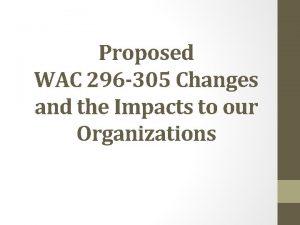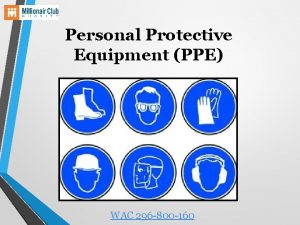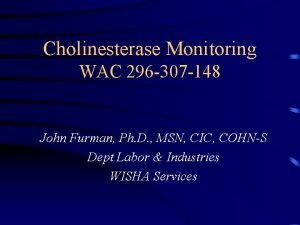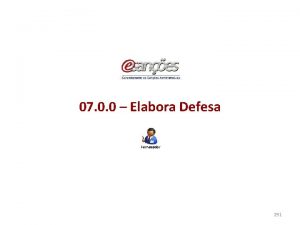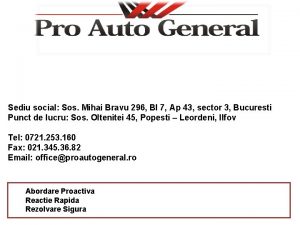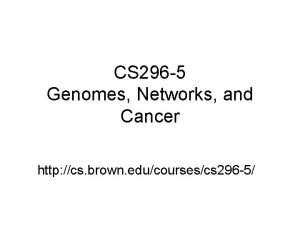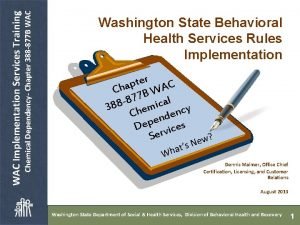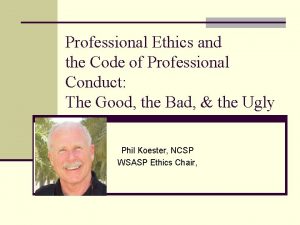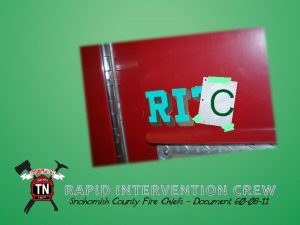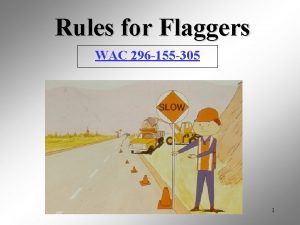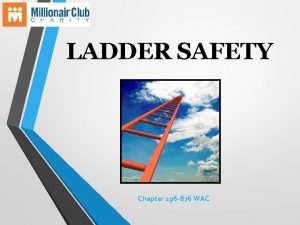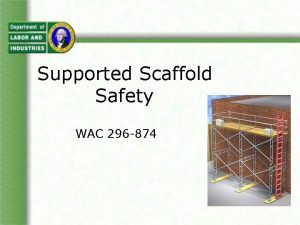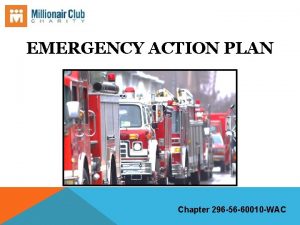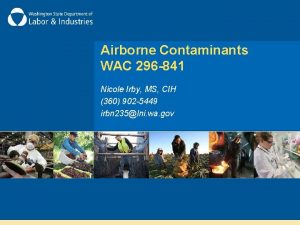C Reference WAC 296 305 Safety Standards for
















- Slides: 16

C

Reference • WAC 296. 305 Safety Standards for Firefighters • NFPA 1407 Standard for Training Fire Service Rapid Intervention Crews, 2010 edition • Snohomish County Fire Chiefs Incident Management System Policies The RIC procedure was developed by the Snohomish County Training Officers (SCTO). Input was received from numerous Snohomish County Fire Agencies to create a document that would be universal throughout Snohomish County. SCTO understands that each department may need to make changes to this procedure to “work” for each agency. Our goal is to keep the procedure intact to ensure all companies operating on an incident understand each others tactical operations.

Definitions • C. A. N Report • Conditions • Actions • Needs UCAN and CANA are other variations of the more popular CAN report. UCAN is stating your unit identification. CANA is a report of your air after the conditions , actions and needs. • IDLH (Immediately Dangerous to Life and Health. • Defines in WAC 296 -62 -07105 as “an atmosphere that poses a threat to life, would cause irreversible adverse health effects or would impair an individuals ability to escape from a dangerous atmosphere. ” • Incipient Fire • A fire which is in the initial stage and which can be controlled or extinguished by a portable fire extinguisher, class II standpipe or small hose systems. • Initial Stages of an incident • Includes the period of an incident when tasks are being undertaken by the first arriving companies with only one team assigned or operating within the IDLH. • Mayday • The term used when a firefighter(s) needs immediate assistance.

Definitions • Softening the Building • Proactive measure taken by a RIC members at the direction of the RIC Group Supervisor (RGS) to assure that egress route are established prior to any potential firefighter emergency. • Before making any opening that could affect the ventilation profile the RGS must receive approval from the Incident Commander. • Rapid Intervention Crew (RIC) • A dedicated crew of firefighters who are assigned for rapid deployment to rescue lost or trapped firefighters. It is highly recommended that a minimum of three firefighters be assigned to RIC. • Standby Firefighters • Refers to the firefighters who are assigned to standby outside the IDLH area ready to respond to a firefighters emergency. Standby firefighters can be assigned other tasks while standing by. Standby firefighters need to wear full PPE including SCBA in the sandy by position and shall consist of a minimum of two personnel. Standby firefighters provide for compliance with 2 in/2 out requirements.

When? RIC will be considered following WAC 296. 305. 05001 (10)(f) When personnel on the scene have been assigned to accomplish the initial strategies and tactics (suppression, search, ventilation, back up line) the incident commander shall consider the establishment of a RIC. It is the policy of all agencies adopting this document to follow WAC 296. 305: Early consideration should be given to providing one or more rapid intervention teams commensurate with the needs of the situation.

What about 2 in / 2 out? • Driver/operators on a 3 person crew need to have their SCBA donned in the stand by position prior to any rescue attempt. They must remain in positive communications with the entry team. • Command officers that arrive before other companies can be used as part of the stand by crew when appropriate gear is donned. • If no imminent life hazard, do not enter the structure until the two outside are ready and have communication with the entry team. Civilian rescue shall only be made when the officer has significant reason to believe there is a life hazard. Entry due to the assumption that all structures are occupied until proven wrong will not be allowed. Other duties outside the structure may be performed in preparation for entry while other resources arrive.

GO or NO GO The incident Commander shall not allow RIC deployment into the following, but not limited to “NO GO” situations: • • Extreme hazard to RIC companies with a high likelihood of severe injury or death Uncontrolled fire growth Eminent collapse No potential to save a live firefighter RIC companies must wait until the Incident Commander has given a “GO” command to the RGS.

RIC Formation (pre-MAYDAY) When a company is assigned to establish RIC, that company will find a location near the structure but outside of the IDLH to lay out a tool cache and green tarp. The RIC should: • Perform a 360 size up • Consider second means of egress • Consider softening the building • Consider gathering all RIC bags on the scene for placement in the RC tool cache The company officer will assume the role of RIC Group Supervisor (RGS). RGS shall be issued a second portable radio in the event of a RIC deployment. RIC may support fire ground operations in the area of the RIC tool cache. RIC personnel will NOT be assigned other tasks.

RIC Formation (pre-MAYDAY) • 2 firefighters with PPE, Portable Radio & SCBA • Green tarp • RIC pack • Air bottle • Mask • Universal air connection • Wire cutters This is a minimum list. Some departments may want to alter this list. Remember…The initial RIC should travel light and fast. A secondary RIC pack may be the bigger tool cache carried by supplemental RIC’s

RIC Formation (pre-MAYDAY) • Power saws • Ground ladders • Maul or sledge hammers • Pry or wrecking bars • Hydraulics power tools • Struts / Hi-lift jacks • Cribbing • Stokes basket and/or backboards • BLS/ALS kits

RIC Deployment (post-MAYDAY/EMER) • Acknowledge the MAYDAY/EMER activation • If the firefighter calling a MAYDAY is coherent, consider having him/her activate the EMER button to move that firefighter to EMER channel. • Declare emergency radio traffic • Determine the nature of the emergency and who is involved • Get Acknowledgment from dispatch agency and emergency tones • Give GO or NO GO to RGS • Request an addition alarm to assist with ongoing firefighting operations and/or RIC activities • Emergency PAR • Face-to-face with RGS • Consider separate tactical channel for RIC activities • Re-evaluate the incident action plan

RIC Deployment (post-MAYDAY/EMER) • Do NOT deploy until directed by the Incident Commander • GO or NOT GO • Determine to the greatest extent possible to following information: • Nature of emergency • Who is involved? Company(s) and name(s) • Last known location and assignment • The needs of the firefighters • If possible make contact with firefighters in trouble • Instruct the firefighters to activate their pass alarms intermittently • Make contact with other companies who are or were working in the same area as the company in trouble. • Formulate a plan • Request additional companies be assigned to RIC • At least one RIC shall be ready to deploy at all times.

RIC Deployment (post-MAYDAY/EMER) • As other companies are assigned to RIC ensure the following: • Correct radio channels for RIC • RIC understands who is in trouble. Company and name. • What has been done previously • Consider a medical team ready to receive firefighters • Minimum of 1 ALS unit for each troubled firefighter • Consider obtaining an aide for RGS • Keep IC updated with RIC activities • Ensure an additional alarm has been requested by the Incident Commander

RIC Deployment (post-MAYDAY/EMER) • While waiting for the GO or NOT go the RIC members should perform a 360 hot lap around the structure. 1 firefighters going clockwise the other firefighter counter-clockwise. Look for structural changes and listen for PASS alarms or firefighters calling out for help. Report back to RIC area and await deployment from RGS. On the hot lap if your hear a PASS or hear firefighters calling for help but cannot see or reach them, return to RIC area and report your findings. You may want to start your search area from where you heard the PASS. Only delay your return to the RIC area if you can positively make a difference in rescuing a firefighter. Radio your intentions to the RGS. • Utilize good tool management • Initial RIC should travel light and fast. Their primary task to located the firefighter(s) in trouble and get air to the mask if needed. Radio to the RGS any needs for firefighter removal • CAN report to the RGS • Follow sound air management practices Do you know who you’re looking for?

RIC Deployment (post-MAYDAY/EMER) • When the troubled firefighter is located: • Silence the PASS alarm (listen for more) • Check air supply or troubled firefighter(s) and RIC • Discover the following: • Is the firefighter conscious or unconscious • Is the firefighter alive or deceased • Is the firefighter entangled or entrapped • Is the firefighter ambulatory or will need assistance • Perform a 360 sweep of the area for other hazards or troubled firefighters • Radio your needs to RGS. E 31 to RIC group E 31 from RIC group go ahead E 31 needs pinch point bars and cribbing an two more companies. We found one downed firefighter unconscious from E 81. E 31 is less than 50 on air. E 31, RIC group copies…E 31 needs pinch point bars and cribbing and two more companies. you found one downed firefighter unconscious from E 31 is less than 50 on air E 31…Affirmative

This presentation shared by Snohomish County Fire District 7
 Wac 296 305
Wac 296 305 Wac 296-305
Wac 296-305 Wac 296-305
Wac 296-305 Wac 296-800-160
Wac 296-800-160 When placing solid web members for beams/columns
When placing solid web members for beams/columns Wac 296-307
Wac 296-307 Nnpj-296
Nnpj-296 Executari silite bucuresti mihai bravu
Executari silite bucuresti mihai bravu E-296
E-296 Cs 296
Cs 296 Reference node and non reference node
Reference node and non reference node Reference node and non reference node
Reference node and non reference node Mnemjian inventories
Mnemjian inventories Wac 388-877
Wac 388-877 Wac 181-87-060
Wac 181-87-060 Bumper-wac
Bumper-wac Conmmitment
Conmmitment


